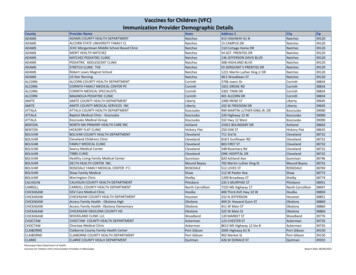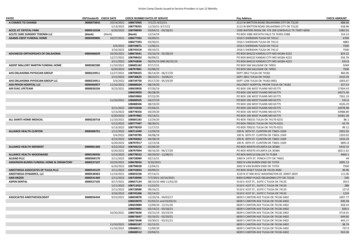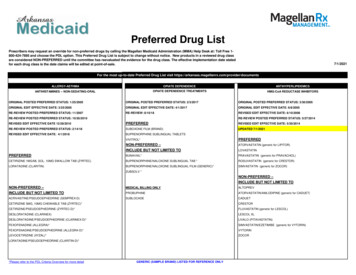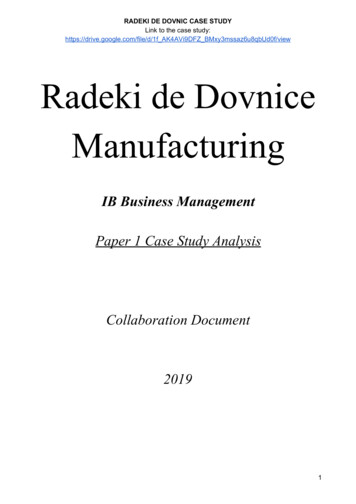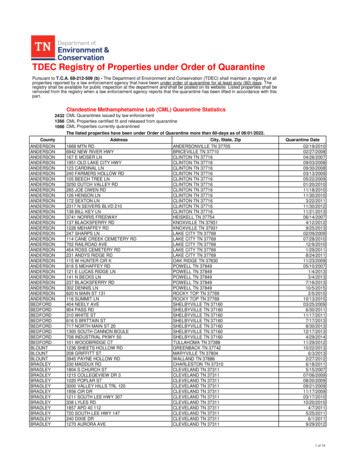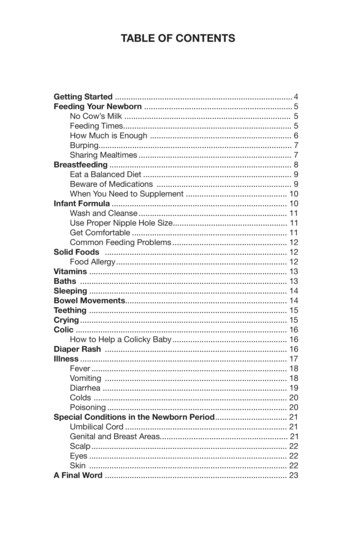
Transcription
table of contentsGetting Started . 4Feeding Your Newborn . 5No Cow’s Milk . 5Feeding Times. 5How Much is Enough . 6Burping. 7Sharing Mealtimes . 7Breastfeeding . 8Eat a Balanced Diet . 9Beware of Medications . 9When You Need to Supplement . 10Infant Formula . 10Wash and Cleanse . 11Use Proper Nipple Hole Size. 11Get Comfortable . 11Common Feeding Problems . 12Solid Foods . 12Food Allergy . 12Vitamins . 13Baths . 13Sleeping . 14Bowel Movements. 14Teething . 15Crying . 15Colic . 16How to Help a Colicky Baby . 16Diaper Rash . 16Illness . 17Fever . 18Vomiting . 18Diarrhea . 19Colds . 20Poisoning . 20Special Conditions in the Newborn Period . 21Umbilical Cord . 21Genital and Breast Areas. 21Scalp . 22Eyes . 22Skin . 22A Final Word . 233
Getting StartedWhen babies go home from the hospital nursery, everyone wantsto see them. A new baby generally gets lots of callers. For a fewweeks, limit your baby’s visitors, especially children. The babyneeds a little time to build resistance to common infections. Youdon’t know who might have a sore throat, cough or other infectiousconditions. We also suggest that you keep the baby out of largecrowds for a few weeks.We ask that our newborn patients come for their first check-ups by3 or 4 days of age. Should a problem arise before then, we’ll seeyour baby, of course. Please call our office as soon as your babygoes home from the hospital to schedule your first appointment.The American Academy of Pediatrics has a recommendedschedule of well-child visits that we’d like you to follow duringyour child’s first two years.Figure 1. Recommended immunization schedule for persons aged 0 through 18 years – 2013.(FOR THOSE WHO FALL BEHIND OR START LATE, SEE THE CATCH-UP SCHEDULE [FIGURE 2]).These recommendations must be read with the footnotes that follow. For those who fall behind or start late, provide catch-up vaccination at the earliest opportunity as indicated by the green bars in Figure 1. To determine minimumintervals between doses, see the catch-up schedule (Figure 2). School entry and adolescent vaccine age groups are in bold.VaccinesBirthHepatitis B1 (HepB)1st dose1 mo2 mos4 mos6 mos9 mos12 mos2nd dose15 mosRotavirus (RV)RV-1 (2-dose series); RV-5 (3-dose series)1st dose2nd doseSeefootnote 2Diphtheria, tetanus, & acellular pertussis3(DTaP: 7 yrs)1st dose2nd dose3rd doseHaemophilus influenzae type b5 (Hib)1st dose2nd doseSeefootnote 53rd or 4th dose,see footnote 5Pneumococcal conjugate6a,c (PCV13)1st dose2nd dose3rd dose4th dose1st dose2nd dose218 mos19–23mos2-3 yrs4-6 yrs7-10 yrs11-12 yrs13–15 yrs16–18 yrs3rd dose4th dose5th doseTetanus, diphtheria, & acellular pertussis4(Tdap: 7 yrs)(Tdap)Pneumococcal polysaccharide6b,c (PPSV23)Inactivated Poliovirus (IPV)( 18years)7Influenza8 (IIV; LAIV)2 doses for some : see footnote 83rd dose4th doseAnnual vaccination (IIV only)Annual vaccination (IIV or LAIV)Measles, mumps, rubella9(MMR)1st dose2nd doseVaricella10 (VAR)1st dose2nd doseHepatitis A11 (HepA)2 dose series, see footnote 11Human papillomavirus (HPV2: femalesonly; HPV4: males and females)12(3-doseseries)Meningococcal13 (Hib-MenCY 6 weeks;MCV4-D 9 mos; MCV4-CRM 2 yrs.)Range of recommendedages for all childrensee footnote 13Range of recommended agesfor catch-up immunizationRange of recommended agesfor certain high-risk groups1st doseRange of recommended ages duringwhich catch-up is encouraged and forcertain high-risk groupsboosterNot routinely recommendedThis schedule includes recommendations in effect as of January 1, 2013. Any dose not administered at the recommended age should be administered at a subsequent visit, when indicated and feasible. The use of a combination vaccine generally is preferred over separate injections of its equivalent component vaccines. Vaccination providers should consult the relevant Advisory Committee on Immunization Practices (ACIP) statementfor detailed recommendations, available online at http://www.cdc.gov/vaccines/pubs/acip-list.htm. Clinically significant adverse events that follow vaccination should be reported to the Vaccine Adverse Event ReportingSystem (VAERS) online (http://www.vaers.hhs.gov) or by telephone (800-822-7967).Suspected cases of vaccine-preventable diseases should be reported to the state or local health department. Additional information,including precautions and contraindications for vaccination, is available from CDC online (http://www.cdc.gov/vaccines) or by telephone (800-CDC-INFO [800-232-4636]).Recommended Office VisitsThis schedule is approved by the Advisory Committee on Immunization Practices (http://www.cdc.gov/vaccines/acip/index.html), the American Academy of Pediatrics (http://www.aap.org), the American Academy ofFamily Physicians (http://www.aafp.org), and the American College of Obstetricians and Gynecologists (http://www.acog.org).recommendations must be read along with the footnotes of this schedule.AgeReason for VisitAge NOTE: The aboveReasonfor Visit— Recommended immunization schedule for persons aged 0 through18 years—United States,20139moHemoglobinTest, Physical Exam3-4 daysFootnotesPhysicalExamFor further guidance on the use of the vaccines mentioned below, see: oPhysicalExam2 wks-1 mo Recheck15 moPhysical Exam, Vaccinations2 moPhysical Exam, Vaccinations18 moPhysical Exam, Vaccinations4 moPhysical Exam, Vaccinations24 moPhysical Exam6 moPhysical Exam, Vaccinations30 moPhysical Exam3 yrsThen Yearly Physical Exams1. Hepatitis B (HepB) vaccine. (Minimum age: birth)Routine vaccination:At birth Administer monovalent HepB vaccine to all newborns before hospital discharge. For infants born to hepatitis B surface antigen (HBsAg)–positive mothers, administer HepB vaccine and0.5 mL of hepatitis B immune globulin (HBIG) within 12 hours of birth. These infants should be testedfor HBsAg and antibody to HBsAg (anti-HBs) 1 to 2 months after completion of the HepB series, at age 9through 18 months (preferably at the next well-child visit). If mother’s HBsAg status is unknown, within 12 hours of birth administer HepB vaccine to all infantsregardless of birth weight. For infants weighing 2,000 grams, administer HBIG in addition to HepB within12 hours of birth. Determine mother’s HBsAg status as soon as possible and, if she is HBsAg-positive, alsoadminister HBIG for infants weighing 2,000 grams (no later than age 1 week).Doses following the birth dose The second dose should be administered at age 1 or 2 months. Monovalent HepB vaccine should beused for doses administered before age 6 weeks. Infants who did not receive a birth dose should receive 3 doses of a HepB-containing vaccine on a scheduleof 0, 1 to 2 months, and 6 months starting as soon as feasible. See Figure 2. The minimum interval between dose 1 and dose 2 is 4 weeks and between dose 2 and 3 is 8 weeks. Thefinal (third or fourth) dose in the HepB vaccine series should be administered no earlier than age 24 weeks,and at least 16 weeks after the first dose. Administration of a total of 4 doses of HepB vaccine is recommended when a combination vaccinecontaining HepB is administered after the birth dose.Catch-up vaccination: Administer a 5-dose series of DTaP vaccine at ages 2, 4, 6, 15–18 months, and 4 through 6 years. The fourthdose may be administered as early as age 12 months, provided at least 6 months have elapsed since thethird dose.Catch-up vaccination: The fifth (booster) dose of DTaP vaccine is not necessary if the fourth dose was administered at age 4years or older. For other catch-up issues, see Figure 2.4. Tetanus and diphtheria toxoids and acellular pertussis (Tdap) vaccine. (Minimum age: 10 years forBoostrix, 11 years for Adacel).Routine vaccination: Administer 1 dose of Tdap vaccine to all adolescents aged 11 through 12 years. Tdap can be administered regardless of the interval since the last tetanus and diphtheria toxoid-containingvaccine. Administer one dose of Tdap vaccine to pregnant adolescents during each pregnancy (preferred during27 through 36 weeks gestation) regardless of number of years from prior Td or Tdap vaccination.Catch-up vaccination: Persons aged 7 through 10 years who are not fully immunized with the childhood DTaP vaccine series,should receive Tdap vaccine as the first dose in the catch-up series; if additional doses are needed, use Tdvaccine. For these children, an adolescent Tdap vaccine should not be given. Persons aged 11 through 18 years who have not received Tdap vaccine should receive a dose followedby tetanus and diphtheria toxoids (Td) booster doses every 10 years thereafter. An inadvertent dose of DTaP vaccine administered to children aged 7 through 10 years can count as partof the catch-up series. This dose can count as the adolescent Tdap dose, or the child can later receive a4
Feeding Your NewbornBreast milk is the best food for babies during the first year oflife. Breast milk provides just the right balance and amounts ofnutrients that babies need for good growth and development.And it contains substances that may help protect babies againstcertain illnesses and allergies. If you choose not to breastfeed orif you stop nursing before your baby’s first birthday, infant formulaprovides the best alternative to breast milk. We recommend oneof the following:Infant Formulas for Baby’s First Year and Beyond Similac Early Shield Enfamil Premium Newborn* Never use low Iron FormulaFat is an important source of energy and nutrition for your baby. Infact, breast milk is about 50% fat. Specific fats have specific rolesas your baby’s eyes, brain and central nervous system develop.The blend of fats in Similac Early Shield and Enfamil PremiumNewborn is very similar to the blend of fats in breast milk.No Cow’s MilkThe American Academy of Pediatrics advises that you keep yourbaby on breast milk or formula until his or her first birthday. Cow’smilk in any form - whole, 2 percent or skim - should not be givenuntil your child is one year old. Cow’s milk doesn’t supply thebalanced nutrition your baby needs, and it’s often hard on baby’ssensitive digestive systems.Feeding TimesBabies differ in their feeding needs and preferences, but mostbreast-fed babies need to be fed every 2 to 3 hours and nurse 10to 20 minutes on each breast. Formula-fed babies usually feedevery 3 to 4 hours and finish a bottle in 30 minutes or fewer. Bottlefed infants drink about 2 to 4 ounces at first; by the time they’re afew weeks old, their formula consumption has generally doubled.5
Your new baby may cry as though asking to be fed as often asevery 2 hours. Keep in mind, though, that babies don’t need to befed every time they cry. When a baby cries for a short time on aregular basis, he may just need more milk at each feeding. Or hemay be protesting that his diaper is wet or that he’s too hot. It’sbest not to get into the habit of offering frequent small feedings toplease a fussy baby. So, before you offer the breast or bottle, besure your baby’s not crying for some reason unrelated to hunger.Let your newborn set his own feeding schedule. Don’t watch theclock for him. He knows how much and how often he needs toeat. And don’t wake him up for a feeding unless it’s been at least5 hours since the last one.How Much Is Enough?How can you tell whether your baby’s getting enough breast milkor formula? The best gauge of good nourishment is growth. Thisis measured by weight and length. Each time your baby comes infor a check-up, we’ll weigh and measure him. It’s one reason yourbaby needs regular check-ups during the first two years.Signs of a Well Fed Baby Looks and acts satisfied after feedings Wets six or more diapers daily (after 4-5 days of age) Has yellow stools or frequent dark stools (after 4-5 days of age)Most new babies weigh between 5½ and 10 pounds. The averageis about 7½ pounds. During the first days of life, infants generallylose 4 to 10 ounces; breast-fed babies may lose a little more. Thisis no cause for concern. It’s all part of your baby’s adjustment tothe outside world, and most of the weight loss is water. By 10 daysof age, most babies gain back what they lost.Healthy, well-fed babies usually double their birth weight by 5months and triple it by 1 year.6
BurpingBurping your baby helps remove air swallowed during feeding.You can wait until the end of the feeding or burp at intervals duringthe feeding. You’ll soon be able to tell if your baby needs frequentburping. Here are three good methods: Hold your baby so his head rests on your shoulder and hischest is against yours. Pat his back or rub it upward with yourhand. Lay your baby face down on your lap. Rub or pat his back. Hold your baby in a sitting position on your lap, with his sidetoward you. Support his head and back with one hand, chinand chest with the other. Then gently rock him back and forthas if helping him “take a bow”.Your baby may spit up small amounts of formula or breast milk,too. No cause for alarm. It happens to all babies. You may beable to reduce the spitting up by burping your baby more often orlonger during and after feedings.Sharing MealtimesMealtime is more than an opportunity to get nutrients into yourbaby. It’s a time for closeness and sharing. Your baby’s meals areas much for his emotional pleasure as his physical well-being. So,maintain eye contact with your baby while you feed him. Hold himcomfortably close to you, seating him in your lap with his headresting in the bend of your elbow and slightly raised. Talk to himsoftly during the feeding.7
BreastfeedingHuman milk is made especially for human babies. There are manyadvantages to breastfeeding your newborn, including less colic,a lower rate of ear infections, fewer allergies and some believea lower risk of SIDS. There is also the convenience factor and ofcourse, the savings. This brief outline is intended to get you startedon that special path that nursing mothers share with their babies.The first few days of nursing will be a time of learning for you andyour baby. Neither of you may accomplish a lot on your first fewtries, but that’s alright. A clear or yellowish fluid called colostrumthat’s extra rich in nutrients will come from your breasts. Althoughthe amount will be small, it’s close to what your infant’s stomachcan hold.To begin, find a comfortable position that gives you good supportof your back and arms - using pillows can help this. There arethree main nursing positions; sitting with the baby in your lap,lying on your side, and the football-hold position. In each of thesepositions, it is very important that the baby’s face and chest arefacing your body, tummy to tummy. Hold your breast with fourfingers underneath and your thumb on top; this helps you directyour nipple and areola into the baby’s mouth. Do not use thescissor hold as this flattens the nipple and makes it difficult tolatch on.Latching on is one of the most important parts of breastfeeding.The infant must have your nipple and about an inch of breast in themouth. Tickle the baby’s lips with your nipple, or express a littlebreast milk to interest him in latching on. Keep his head tucked inrather than tipped back.Nurse for a total of 20 minutes during each feeding by the end ofthe first week. Sometimes five minutes on the first side and theremainder on the other breast is a good way to nurse. This methodprevents the baby from becoming too sleepy on the first sideand taking nothing from the other breast, causing it to becomeengorged. Don’t forget to drink two cups of water each time you8
nurse. Remember you’re still eating and drinking for two. If yourbreasts become engorged, apply warm compresses and manuallyexpress or pump some milk before putting the baby to nurse.Your breasts will feel normal again between the third and fourthweeks. Don’t think that you’re losing your milk supply and startsupplementing with formula - the baby won’t nurse as vigorouslyand your supply will dwindle.This is only a guide. If you are having problems with nursing, thereare many resources available. Please call during office hours andwe will be happy to assist you.Eat a Balanced DietAs a nursing mother, you’ll need to eat a balanced diet that contains500 to 600 calories more per day than the diet you needed beforepregnancy. Your daily food intake should contain a lot of proteinfoods and at least one quart of milk; these foods provide you withenough calcium for both you and your baby. If you’re unable todrink milk or eat high calcium foods, ask your doctor to recommenda calcium supplement.Foods in mothers’ diets rarely have a disturbing effect on theirbabies. It does happen, though, with certain foods such astomatoes, onions, cabbage, chocolate and spicy foods. If yourbaby has loose stools, colic or excess gas for no reason thatyou can think of, review your diet for the previous 24 hours. Tryeliminating foods on the above list and see if it helps.Beware of MedicationsMedications taken by a mother can pass into her breast milk. Thisapplies to both prescription and over-the-counter drugs. Examplesare sedatives taken for sleep, tranquilizing agents, other moodaltering drugs, laxatives and antibiotics. If you’re breastfeeding,please check with us before taking any medication - even seeminglyharmless nonprescription drugs. We will want to discuss with youwhether a medication will reach your baby through your milk.9
When You Need to SupplementSometimes breasfeeding mothers need or choose to give theirbabies some bottle-feedings of infant formula. It’s quite possibleto balance breast feedings and bottle-feedings, but we advisenew mothers against the practice until their breast milk supplyis established, usually a matter of several weeks. And if you dosupplement with formula, you should continue to express yourbreast milk in order to maintain your milk supply. Generally,breastfeeding babies shouldn’t even be given water during thisperiod unless they’re exposed to very warm weather. After yourmilk supply is steady and reliable, you may give a couple of ouncesof water once or twice daily between feedings.Infant FormulaIf you’re bottle-feeding your baby, infant formula should be the onlyform of milk your baby gets during the first year of life. Similac EarlyShield or Enfamil Premium Newborn is the formula we recommendand is available in three forms. Ready-To-Use is fed without addingwater. Concentrate is a liquid that’s been condensed and must bediluted with water. Powder must be dissolved in water. The colorsof the cans are the same; be sure you are buying the right formulaby the container size and the written description of Ready-To-Use,Concentrate and Powder.Similac Early Shield Container Size What To DoReady-To-Use8 & 32 oz cans Pour in clean bottleConcentrate13 oz cans Mix equal parts ofwater and formulaPowder14, 16 or Mix 1 scoop with32 oz cans 2 oz waterNote: Always follow directions for mixing and serving exactly.When your baby comes home from the hospital, he’ll probablytake 2 to 4 ounces of prepared formula at each feeding. When he’sable to empty the bottle, start adding another ounce.10
Wash and CleanseCleanliness is important for small babies, especially when it comesto things that go into their mouths. So you’ll need to be carefulabout keeping formula containers, bottles, nipples, and utensilsfree of germs. Everything must be washed thoroughly in hot soapywater and rinsed with plain hot water. Utensils must be kept offunclean surfaces. You should wash your hands well with soap andwater before beginning formula preparation.You can prepare enough formula for one feeding or for a wholeday. After each feeding, rinse the bottle and nipple with cool water.If you rinse the milk away before it can form a film, washing will beeasier later.Use Proper Nipple Hole SizeThe size of the nipple hole should be large enough to let milkdrip through at a steady rate without forming a stream. If the milkdoesn’t form separate drops, throw the nipple away. If the holeis too small, enlarge it by pushing a sterilized needle or cleantoothpick through the hole.As you feed your baby, hold the bottle so formula fills the nippleand the baby can’t suck any air through. Too much swallowedair will give him a false feeding of being full. He could also getuncomfortable from gas later.Get ComfortableBefore you start a feeding, make sure your baby’s ready . Heshould be wide awake, hungry, warm and dry. And you should sitin a chair with him where you’re comfortable and relaxed. Hold himclose to you in the nursing position, his head slightly raised andresting in the bend of your elbow.Never prop your baby’s bottle or let him feed by himself. Not onlydoes it deprive your baby of needed contact with you, but smallunattended babies have been known to choke when left with apropped bottle.11
Common Feeding ProblemsFussiness, crying, gas, diarrhea - babies occasionally develop oneor more of these symptoms. If your baby has any of these, callthe office. Be prepared to describe the symptoms your baby isexperiencing, when they occur and how long they last.Solid FoodsMany parents are proud of the day their baby begins to take solidfoods, including cereals. They view it as an accomplishment. As aresult, many babies are started on solid foods before their digestivesystems are really ready. From a nutritional standpoint, solid foodsare not necessary during the first 4 to 6 months of life. Breast milkor full-year formula provides all the nutrients a baby needs. In fact,the earlier any food is introduced, the greater the chances are thatthe baby will have problems with it.New foods should be introduced one at a time. When a new food isintroduced, no-other new foods should be given over the next fewdays. Unless instructed by us, you should not change formulasat the same time that you are introducing solid foods. If the foodcauses diarrhea, constipation, or a rash, you should stop givingit. By introducing new foods slowly, you give your baby’s systema chance to adjust, and it’s easier to trace problems back to thesource. If a food doesn’t agree with your baby, try it again whenthe baby is older.Food AllergyA true allergy to a food is not very common in infants, and can becontrolled by changing the formula or diet. The best way to helpyour baby avoid allergies is to breastfeed. Occasionally a formulafed baby may develop symptoms that might indicate an allergy,such as colic, severe rash, eczema, or diarrhea that won’t clear up.If there is a history of allergy in your family, these symptoms areeven more likely to indicate an allergy. That’s why you should tellus if allergies run in your family.12
VitaminsWe sometimes ask the parents of our young patients to givetheir infants and children vitamin-mineral supplements. (Somesupplements are by prescription-only because they containfluoride. In addition children may receive fluoride from their watersupply and other sources.) All breatfeeding infants should receiveVitamin D supplementation daily.BathsFor the first few days after your baby comes home, bath timecan consist of a gentle once-over with a soft, damp washcloth warm, of course - and a mild soap. Regular baths should wait untilwhat’s left of the umbilical cord has come off - and, in the caseof boys, until the circumcision heals. Once your baby is ready forfull fledged baths, be sure the room is warm, with no drafts, andthe water is about 85 F. When you stick your elbow in the water, itshould feel warmer than your skin but not actually hot.Your baby will find bath time a highlight of his day if you take a fewprecautions to keep soap out of his eyes and mouth and make himcomfortable. Wash your baby’s face with plain water, a soft clothand a mild soap. Wash your baby’s head gently, working from frontto back to keep the soap out of his eyes.To clean the area around the eyes, use cotton dipped in cool clearwater. Clean the outer areas of the nose and ear only, using amoist washcloth or cotton ball dipped in water. With a cotton ball,wipe away any yellow-orange earwax that’s collected in the visiblepart of his ear. It’s important not to poke inside the ear; it’s risky foryour baby, painful and unnecessary.Don’t try to clean any areas inside his mouth until he starts gettingteeth; then you can teach him to use a toothbrush.13
SleepingNewborn babies sleep a lot, usually waking up every 2 to 4 hoursfor feedings. At about 1 to 2 months of age, they generally startsleeping through the night, although a few cooperative babies startsooner. You may have heard that starting solid food will make ababy sleep through the night; there’s no evidence that this is true.Between 5 and 7 months of age, your baby may disappoint you bystarting to wake once again during the night. This isn’t backsliding.It’s a normal developmental phase. Let him stay in her bed, comforthim, pat him on the back, and change him if needed. The patternof night-time sleeping will soon return.The American Academy of Pediatrics recommends that an infantsleep on their back or side to reduce the risk of SIDS.Bowel MovementsYour baby’s stools will probably change in color, softness, andfrequency from time to time. Also, different babies have differentbowel habits. Some have a stool with every feeding; others mayhave one stool every 36 to 48 hours. The consistency and colorvaries from day to day. Usually, breast-fed infants have liquid,yellow or mustard-colored stools. If you’re breastfeeding yourbaby, don’t take runny stools as a sign of diarrhea. The stools offormula-fed infants are yellowish-tan. All babies sometimes havegreen, brown or gray-colored stools.As long as your baby seems happy and content, is eating normally,and has no signs of illness, don’t worry about minor changes inthe stools. And if he strains, grunts or turns red in the face whilehaving a bowel movement, that’s normal too.If your baby’s stools are small and pebble-like, he may haveconstipation. Constipation has nothing to do with frequency ofstools. Don’t give him an enema, suppository or laxative untilyou’ve talked to us.14
TeethingMost babies start teething at 6 to 7 months. A few early birdsbegin at 3 to 4 months. While the majority of babies aren’t troubledby the teething process, some get irritable, eat poorly and havetrouble sleeping when teeth begin to arrive.CryingWays that tiny babies can communicate are limited. Crying is oneof them. Crying is how your baby makes his needs known and hisdispleasure felt. As you’ll soon find out if this is your first baby,most parents quickly learn to identify whether their baby is cryingfrom hunger, restlessness, pain, anger, or some other reason.Many babies go through unexplainable fussy periods each day asthey adjust to living in the world. Don’t worry about spoiling a tinybaby by pampering him. He needs to know you’re there to meethis needs.There are a number of things you can do to comfort your baby: Give the baby something to suck, such as a pacifier. Lengthen feeding times. Give the baby more physical contact and movement. Walk, rockor pat him.
The American Academy of Pediatrics has a recommended schedule of well-child visits that we'd like you to follow during your child's first two years. Figure 1. Recommended immunization schedule for persons aged 0 through 18 years - 2013. (FOR THOSE WHO FALL BEHIND OR START LATE, SEE THE CATCH-UP SCHEDULE [FIGURE 2]).
